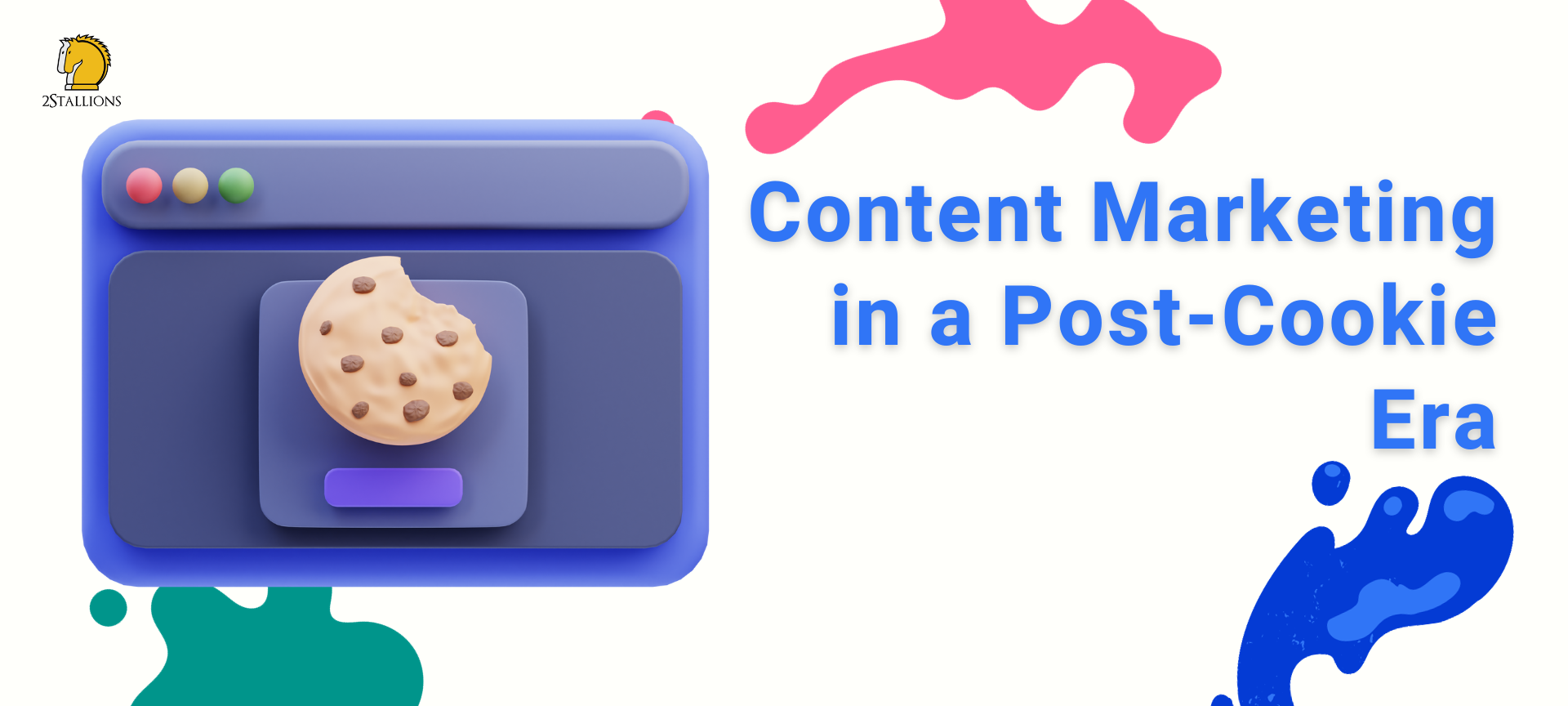Content
SHARE

In today’s ever-evolving digital landscape, content marketing is facing a significant transformation. The era of relying on third-party cookies to track and target consumers is coming to an end. As privacy regulations tighten and browser changes restrict access to user data, content marketers must adapt their strategies to thrive in this post-cookie era.
[thrive_leads id=’8342′]
Understanding the Post-Cookie Era
The demise of third-party cookies marks a fundamental shift in how advertisers and marketers interact with their target audience. Until now, cookies have played a crucial role in collecting user data, enabling personalised and targeted advertising. However, concerns over data privacy and security have prompted regulatory changes and browser updates that restrict the usage of third-party cookies.
The Demise of Third-Party Cookies
In recent years, there has been a growing awareness of data privacy issues and a push for more transparent online practices. As a result, major browsers, like Google Chrome and Apple Safari, are phasing out support for third-party cookies. This move aims to put users back in control of their data and limit the ability of advertisers to track their online activities.
With the demise of third-party cookies, advertisers and marketers are now faced with the challenge of finding alternative methods to reach their target audience. This shift has sparked a wave of innovation in the digital advertising industry, with companies exploring new technologies such as contextual advertising and first-party data collection.
Contextual advertising involves analysing the content of a webpage to determine the most relevant ads to display. By understanding the user browsing context, advertisers can deliver more targeted and personalised advertisements without relying on third-party cookies. This approach respects user privacy and ensures that ads are more relevant and engaging.
On the other hand, first-party data collection has become increasingly important in the post-cookie era. First-party data refers to information collected directly from users through website interactions or voluntary data sharing. With the consent of users, businesses can gather valuable insights about their audience, allowing them to create personalised experiences and tailor their marketing strategies accordingly.
How Privacy Regulations Are Changing the Digital Landscape
Alongside browser changes, privacy regulations such as the General Data Protection Regulation (GDPR) and the California Consumer Privacy Act (CCPA) have imposed stricter guidelines on collecting, handling, and using personal data. These regulations force businesses to provide clearer consent mechanisms and increased transparency, further challenging traditional content marketing practices.
Under the GDPR, businesses must obtain explicit user consent before collecting and processing their personal data. This means that users have more control over their information and can choose whether or not to share it with advertisers. Additionally, the GDPR requires businesses to provide clear and concise privacy policies, informing users about the purpose and scope of data collection.
The CCPA, conversely, grants California residents the right to know what personal information is being collected about them and how it is being used. It also gives them the right to opt out of the sale of their personal information. These regulations aim to give consumers more control over their data and promote transparency in data practices.
As a result of these privacy regulations, businesses are now required to be more transparent about their data collection and usage practices. This has led to a shift in consumer expectations, with users becoming more cautious about sharing their personal information online. Advertisers and marketers must adapt to this changing landscape by prioritising privacy and providing meaningful value to users in exchange for their data.
Overall, the demise of third-party cookies and the implementation of privacy regulations have significantly impacted the digital advertising industry. Advertisers and marketers are now faced with the challenge of finding new ways to reach their target audience while respecting user privacy. This shift has sparked innovation and forced businesses to rethink their strategies, ultimately leading to a more privacy-conscious and user-centric digital landscape.
The Impact on Content Marketing
The decline of third-party cookies poses both challenges and opportunities for content marketers. Let’s explore how this paradigm shift affects their strategies. Content marketing has become integral to digital marketing strategies, allowing brands to engage with their target audience through valuable and relevant content. However, with the decline of third-party cookies, content marketers now face a new set of challenges.
Challenges for Content Marketers
Content marketers face difficulties in targeting specific audiences based on their browsing habits without third-party cookies. The loss of granular user data makes it harder to accurately deliver personalised experiences and measure campaign effectiveness. Marketers must find alternative methods to understand their audience and create relevant content.
One challenge that content marketers face is relying more on first-party data. First-party data refers to the information collected directly from users interacting with a brand’s website or app. While first-party data provides valuable insights, it may not be as extensive or comprehensive as the data obtained through third-party cookies.
Another challenge is the limitation in tracking user behaviour across different websites. Third-party cookies allowed marketers to follow users as they navigated the web, enabling them to deliver targeted content and advertisements. Content marketers must find new ways to understand user behaviour and preferences without this tracking capability.
Moreover, the decline of third-party cookies also affects the measurement of campaign effectiveness. Marketers heavily relied on these cookies to track conversions, measure engagement, and attribute success to specific marketing efforts. With the loss of this tracking mechanism, content marketers need to explore alternative methods of measuring their campaign’s impact and return on investment.
Opportunities in the New Era
While the post-cookie era brings its fair share of challenges, it also presents exciting opportunities for innovation. Content marketers can focus on building stronger relationships with their audience by prioritising first-party data and contextual advertising. Content marketers can better understand their audience’s preferences, interests, and behaviours by leveraging first-party data. This valuable information can help them create more personalised and targeted content, enhancing the overall user experience.
Brands can also leverage this data to develop tailored marketing campaigns that resonate with their audience more deeply. Contextual advertising is another opportunity that arises in the absence of third-party cookies. Instead of relying on user data, contextual advertising focuses on the content and context of a webpage to deliver relevant ads. This approach ensures that ads are displayed contextually, increasing the chances of capturing the user’s attention and driving engagement.
Furthermore, content marketers can explore new strategies such as influencer marketing, user-generated content, and interactive experiences to engage with their audience. These approaches allow brands to tap into the power of social proof, authenticity, and interactivity, creating memorable experiences that resonate with users.The decline of third-party cookies presents challenges for content marketers and opens up opportunities for innovation and creativity. By adapting their strategies and embracing new approaches, content marketers can continue to deliver valuable and engaging content to their audience in the post-cookie era.
Adapting Your Content Marketing Strategy
To navigate this changing landscape, content marketers need to adjust their strategies. By leveraging the following approaches, they can ensure their content remains effective and impactful.
Importance of First-Party Data
First-party data, collected directly from users through website interactions, subscriptions, and user accounts, becomes even more valuable in the absence of third-party cookies. Implementing robust data collection systems and optimising consent mechanisms can help marketers gain valuable insights into their audience’s preferences, behaviours, and interests.
Understanding your audience is crucial for content marketers. Marketers can better understand their audience’s demographics, interests, and preferences by collecting first-party data. This data can then be used to create personalised and targeted content that resonates with their audience on a deeper level.
For example, a clothing brand can collect customer purchase history, browsing behaviour, and preferences. With this information, they can tailor their content to showcase products most likely to appeal to each customer. This increases the chances of conversion and enhances the overall customer experience. Furthermore, first-party data allows content marketers to track the customer journey more effectively. Marketers can identify pain points by analysing how users interact with their website, optimise user experience, and create content that addresses specific needs and concerns.
Embracing Contextual Advertising
In a world without third-party cookies, context becomes vital. Content marketers can shift their focus towards contextual advertising, which relies on the content and context surrounding the ad placement, rather than extensive user profiling. By aligning their message with relevant contexts, marketers can reach their target audience effectively without relying solely on personal data.
Contextual advertising opens up new opportunities for creativity and relevance. Instead of relying on user data, marketers can focus on creating content that seamlessly integrates with the surrounding context. For example, a travel agency can post ads on websites and blogs discussing popular travel destinations. By doing so, they can capture the attention of users who are already interested in travel and increase the chances of engagement.
Moreover, contextual advertising allows marketers to tap into the power of storytelling. By crafting compelling narratives that align with the content they are placed alongside, marketers can create a more immersive and engaging experience for their audience. This approach enhances brand perception and increases the likelihood of users taking action. It’s important to note that while contextual advertising is a valuable strategy, it should be complemented with other tactics to maximise results. By combining contextual advertising with first-party data insights, marketers can create a comprehensive and effective content marketing strategy that delivers results in a privacy-conscious world.
Future-Proofing Your Content Marketing
To thrive in the post-cookie era, content marketers must embrace new technologies and build trust and transparency with their audience. In today’s ever-evolving digital landscape, content marketers face the challenge of adapting to the post-cookie era. With the demise of third-party cookies, marketers must find innovative ways to deliver personalised experiences and engage with their audience. This requires a deep understanding of new technologies and a commitment to building trust and transparency.
The Role of Artificial Intelligence and Machine Learning
Artificial intelligence (AI) and machine learning (ML) play a significant role in unlocking the potential of post-cookie content marketing. These technologies enable marketers to deliver personalised experiences by analysing user interactions, website data, and various signals to understand individual preferences. The power of AI and ML lies in their ability to process vast amounts of data and identify patterns that human marketers might miss.
Marketers can use AI-powered tools to deliver relevant content tailored to each user without relying on third-party cookies. This enhances the user experience and allows marketers to make data-driven decisions and optimise their content strategies. Imagine a user visiting an e-commerce website and browsing through different product categories. With AI and ML, the website can analyse the user’s behaviour, understand their preferences, and recommend products that align with their interests. This level of personalisation not only increases the chances of conversion but also enhances the overall user experience.
Building Trust and Transparency with Your Audience
Content marketers must foster trust and transparency with their audience in a landscape where data privacy is paramount. Openly communicating data collection methods, providing clear opt-in/opt-out mechanisms, and prioritising data security can help marketers build and maintain trust with their audience. Transparency is critical to establishing a solid relationship with users. Marketers should clearly outline how they collect and use data, ensuring that users have a clear understanding of the purpose and benefits.
Marketers can alleviate privacy concerns and create a more positive brand perception by being transparent about data practices. Data security is another crucial aspect of building trust. Marketers must prioritise the protection of user data, implementing robust security measures to safeguard against potential breaches.
Marketers can demonstrate their commitment to data privacy and instil confidence in their audience by investing in data encryption, secure storage, and regular security audits. Furthermore, providing users with control over their data is essential. Marketers should offer clear opt-in and opt-out mechanisms, allowing users to choose the level of data sharing they are comfortable with. Empowering users with these choices respects their privacy and enhances their overall experience with the brand.
By prioritising ethical data practices, marketers can differentiate themselves and establish long-term customer relationships. Trust and transparency are the foundation of successful content marketing in the post-cookie era, and by embracing new technologies and ethical data practices, marketers can future-proof their strategies and stay ahead of the curve.
Conclusion: Thriving in a post-cookie world
In conclusion, content marketers must embrace the post-cookie era by adapting their strategies and leveraging new opportunities. Despite the challenges brought about by the demise of third-party cookies, there are ways to continue delivering impactful content and engaging with target audiences.
Key Takeaways for Content Marketers
- Understand the changes in the digital landscape and stay updated with privacy regulations and browser updates.
- Invest in first-party data collection and optimisation to gain insights into audience preferences.
- Shift towards contextual advertising to reach target audiences effectively without relying solely on personal data.
- Utilise AI and ML technologies to deliver personalised experiences and tailored content.
- Build trust and transparency with your audience through ethical data practices and open communication.
Looking Ahead: The Future of Content Marketing Without Cookies
While the post-cookie era presents challenges, it also paves the way for innovation and creativity. As technology continues to evolve, content marketers will need to stay agile and proactive, adapting their strategies to meet the ever-changing demands of the digital landscape. By embracing new approaches and focusing on audience engagement, content marketers can continue to thrive in a world without cookies.
Frequently Asked Questions About Content Marketing in a Post-Cookie Era
What Is Cookie Based Marketing?
Cookie-based marketing refers to the use of browser cookies to track user behaviour on websites. Marketers use this information to create targeted advertising campaigns, personalised content, and improve user experience. Cookies store data such as user preferences, login details, and browsing history.
How Do Cookies Affect Digital Marketing?
Cookies play a crucial role in digital marketing by enabling advertisers to track user behaviour, understand their preferences, and deliver personalised ads. They help in retargeting campaigns, conversion tracking, and improving overall campaign performance. However, with increasing privacy concerns and regulations, cookies are undergoing significant changes.
What Are the Benefits Of Cookies In Marketing?
- Personalisation: Cookies help in creating a personalised experience for users by remembering their preferences and behaviour.
- Targeted Advertising: Advertisers can deliver more relevant ads to users based on their browsing history and interests.
- Tracking and Analytics: Cookies enable tracking of user interactions with websites, helping in analytics and optimisation of marketing campaigns.
- Improved User Experience: Websites can use cookies to remember login details, shopping cart items, and other user-specific details, improving the overall user experience.
What Is the Cookieless Future in Marketing?
The cookieless future refers to the shift away from reliance on third-party cookies for tracking user behaviour due to increasing privacy concerns, regulations, and changes in browser policies. Marketers adapt by investing in first-party data, exploring alternative tracking methods, and focusing on privacy-compliant data collection methods. This shift emphasises transparency, user consent, and data security, aiming to create a more privacy-focused digital advertising ecosystem.












